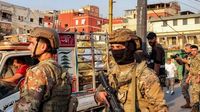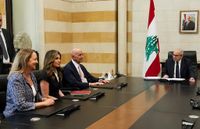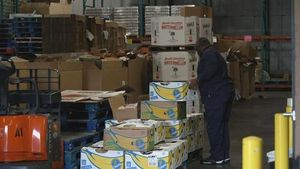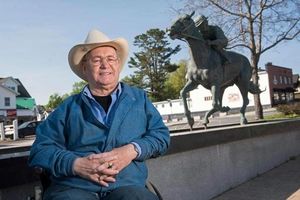On August 21, 2025, a convoy of Lebanese army vehicles rolled into the Burj al-Barajneh refugee camp on the southern edge of Beirut, signaling the start of a long-anticipated—and, for many, controversial—plan to disarm Palestinian groups inside Lebanon’s refugee camps. The scene was both tense and historic: a truck loaded with bags, the butts of machine guns poking out, was escorted out of the camp under the watchful eyes of soldiers and local onlookers. According to AFP and Reuters, this marked the first phase of a broader campaign to collect weapons from Palestinian factions, a move hailed by some as a step toward stability and by others as a symbolic gesture with uncertain prospects.
The action follows a deal reached earlier in 2025 between Lebanese President Joseph Aoun and Palestinian President Mahmoud Abbas. Their May meeting in Beirut produced a joint commitment: all arms in Palestinian camps would be surrendered to the Lebanese state. As reported by Al Jazeera and the Associated Press, the plan’s initial implementation began at Burj al-Barajneh, with further handovers anticipated at other camps—including al-Bass in southern Lebanon—in the coming weeks.
Ramez Dimashkieh, chairman of the Lebanese-Palestinian Dialogue Committee, described the day as “the beginning of the first phase of the process of handing over weapons from inside the Palestinian camps.” He added, “further batches [will] be delivered in the coming weeks from Burj al-Barajneh camp and the rest of the camps.” The Lebanese Prime Minister, Nawaf Salam, echoed this optimism, stating that the process would continue across the country’s 12 camps, long known for operating outside state jurisdiction.
The United States, which has pressed Lebanon to assert greater control over armed groups, was quick to congratulate the move. U.S. envoy Tom Barrack called it “a historic step toward unity and stability, showing true commitment to peace and cooperation.” Barrack also described the agreement as “a great accomplishment as a result of the bold action recently taken by the Lebanese Council of Ministers.”
But the reality on the ground is more complicated than a single truckload of surrendered arms might suggest. According to a Fatah official speaking to Reuters, the weapons handed over so far were “only illegal weapons that had entered the camp within the previous day.” The arms held by Palestinian security personnel—those officially tasked with maintaining order in the camps—were specifically excluded from the handover. And, as several Palestinian sources told AFP, the move is currently limited to Fatah and its allies. Other influential factions, most notably Hamas and Palestinian Islamic Jihad, have not agreed to disarm.
Indeed, representatives from Hamas and Islamic Jihad did not respond to requests for comment from AP. Instead, a Hamas spokesperson issued a statement on behalf of “the Palestinian Factions in Lebanon,” declaring that the handover was “an internal organizational matter within the Fatah movement” and “has no connection, near or far, to the issue of Palestinian weapons in the camps.” The statement continued, “Our weapons have always been and will always be linked to the right of return and the just Palestinian cause and will remain so as long as the occupation remains on Palestinian soil.”
This resistance is rooted in history. Since the mass displacement of Palestinians in 1948, Lebanon’s refugee camps have been more than just crowded neighborhoods—they’ve been strongholds for political and armed groups like Fatah, Hamas, and the Popular Front for the Liberation of Palestine (PFLP). These factions arose from decades of political exclusion, as Palestinian refugees in Lebanon are denied key civil rights such as the ability to own property or access many jobs. For many, the armed groups have provided not just protection but a sense of representation and purpose.
Over the years, the Lebanese government has largely ceded control of the camps. As of 2025, about 222,000 Palestinian refugees live in Lebanon, with the largest concentration in camps like Ain al-Hilweh near Sidon, which also harbors individuals wanted by Lebanese authorities. According to UNRWA, these camps have operated as quasi-autonomous zones, with the state’s influence limited to the periphery.
The new disarmament push is not happening in a vacuum. It comes as Lebanon faces mounting U.S. pressure to also rein in Hezbollah, the powerful Iran-backed group that fought a devastating war with Israel in 2024. That conflict, which ended in a November ceasefire, left Hezbollah weakened but still defiant. The ceasefire stipulated that only the Lebanese military and UN peacekeepers could bear arms in southern Lebanon, but Israel has continued to launch strikes and maintains a presence at five strategic positions in the region.
In response to these pressures, the Lebanese government has tasked the army with formulating a plan to disarm all militant groups—including Hezbollah—by the end of 2025. Yet, as FDD Flash Brief notes, Hezbollah has flatly refused to give up its arsenal, with its leaders warning that any attempt to forcibly disarm the group could plunge Lebanon into civil war. For now, the government’s efforts have focused on Palestinian factions, where the political cost is lower and the likelihood of violent backlash, while real, is less acute than with Hezbollah.
Still, even the disarmament of Palestinian camps is far from assured. Implementation of the plan was delayed for months due to disagreements among and within the various Palestinian factions over how the handover should proceed. As of August 21, 2025, it remains unclear whether all groups will ultimately comply. As one Palestinian security source at Burj al-Barajneh told AFP, “Fatah’s initiative in beginning to hand over weapons is symbolic, and came as a result of an agreement between [President] Aoun and the Palestinian president’s son, Yasser Abbas, who is currently visiting Beirut.” The move, he added, is intended to “encourage the remaining [Palestinian armed] factions to take the same step.”
But for now, armed factions like Hamas remain unmoved. Their message is clear: their weapons are inseparable from the struggle for Palestinian rights and the dream of return. As long as the Israeli occupation persists, they argue, their arms will not be surrendered.
Meanwhile, the international community is watching closely. The United States has reportedly asked Israel to reduce “non-urgent” strikes in Lebanon as the Lebanese army gets to work. There are even reports, as cited by FDD, of Washington floating the idea of an economic zone in southern Lebanon, with Saudi and Qatari investment, if the region stabilizes.
Whether the current steps will lead to a broader disarmament, or simply mark another chapter in Lebanon’s long struggle to assert state authority, remains to be seen. For now, the sight of weapons leaving Burj al-Barajneh is both a hopeful sign and a reminder of how much work lies ahead.





